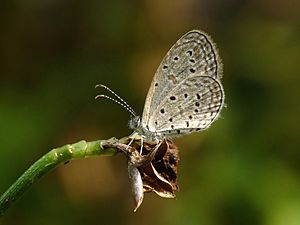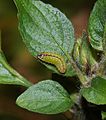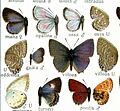Gaika blue facts for kids
Quick facts for kids Tiny grass blue |
|
|---|---|
 |
|
| In Kerala, India | |
| Scientific classification | |
| Synonyms | |
|
The Zizula hylax, also known as the Gaika blue or tiny grass blue, is a very small blue butterfly. It's one of the smallest butterflies you can find!
Contents
Discovering the Tiny Grass Blue Butterfly
This butterfly is known for its beautiful colors and delicate patterns. Let's explore what makes it special.
Male Butterfly Appearance
The male tiny grass blue butterfly has a dull violet-blue color on its upper side. This color can look brighter violet when the light hits it just right.
On the forewings, the edges are thinly brown near the top and wider brown along the outer edge. This brown border usually gets thinner towards the bottom of the wing. There's also a dark brown line along the very edge. The tiny hairs (called cilia) on the wing edges are brownish at the front and white at the back.
The hindwings are a brighter blue than the forewings. Their edges are much more thinly outlined in brown, which blends into a dark brown line along the very edge. The cilia on the hindwings are brown at their base and white at their tips.
Female Butterfly Appearance
The female tiny grass blue butterfly is different from the male. Its upper side is a shiny brown color, with no violet or blue at all. The dark brown lines along the edges of both the forewings and hindwings are very clear.
Underside Markings
The underside of both male and female butterflies is mostly grey.
On the underside of the forewing, you'll see a dark brown curved line in the middle. There are also two small black spots near the top, each surrounded by a thin white ring. A curved line of five more black spots, also ringed with white, stretches across the wing. The spots near the back are somewhat crescent-shaped, while the one at the front is round. Beyond these spots, there are two dusky lines that are continuous at the front but look more like broken spots at the back. A very clear, thin, jet-black line runs along the very edge. The cilia are greyish-white with a blackish-brown line through the middle.
On the underside of the hindwing, there are small, white-ringed black spots. Three spots form a line near the base of the wing. After that, a very curved line of eight spots stretches across the wing towards the top edge and then along it towards the base. There's also a dusky curved line in the middle, similar to the forewing. The markings and cilia along the edges are like those on the forewing, but the outer dusky line is more broken and spotty.
The antennae are black with white rings. The head, chest (thorax), and body (abdomen) are dark brown. Males have a little violet fuzz on their head and chest. On the underside, the mouthparts (palpi), chest, and abdomen are greyish-white.
Where Tiny Grass Blues Live
The tiny grass blue butterfly can be found in many different places around the world. It lives in tropical and subtropical parts of Africa, Asia, and Oceania. This includes countries like India, Japan, the Philippines, Singapore, Swaziland, and even along the north, east, and southern coasts of Australia.
Life Cycle of the Tiny Grass Blue
The tiny grass blue butterfly goes through several stages as it grows, just like all butterflies.
Adult Butterflies
Adult tiny grass blue butterflies are quite small. Their wingspan, which is the distance from one wingtip to the other when the wings are spread out, is about 1.5 cm.
Eggs
The eggs of the tiny grass blue are pale green, round, and flat. They are very tiny, only about 0.5 mm across. The female butterfly lays her eggs one by one on the buds and flowers of plants that the caterpillars will eat.
Caterpillars (Larvae)
When the eggs hatch, tiny caterpillars emerge. These caterpillars are about 0.7 cm long. They are green with a dark red line running down their back. They also have lighter and darker lines along their sides. The sides of the caterpillar's body are hairy, and its head is pale brown.
Pupae
After growing enough, the caterpillar changes into a pupa. The pupa is also about 0.7 cm long. It is green and hairy, and it attaches itself to a plant stem or the underside of a leaf of its food plant. Inside the pupa, the caterpillar transforms into an adult butterfly.
What Tiny Grass Blues Eat
The caterpillars of the tiny grass blue butterfly feed on various plants. These plants belong to a family called Acanthaceae. Some specific plants they are known to eat include Hygrophila auriculata and Phaulopsis dorsiflora.
Images for kids







